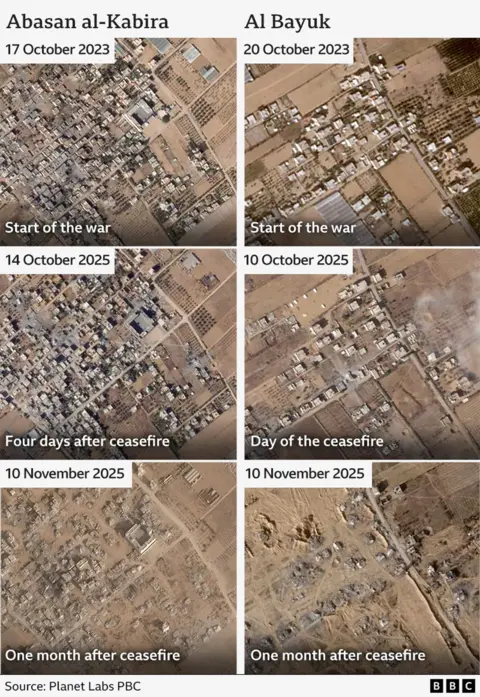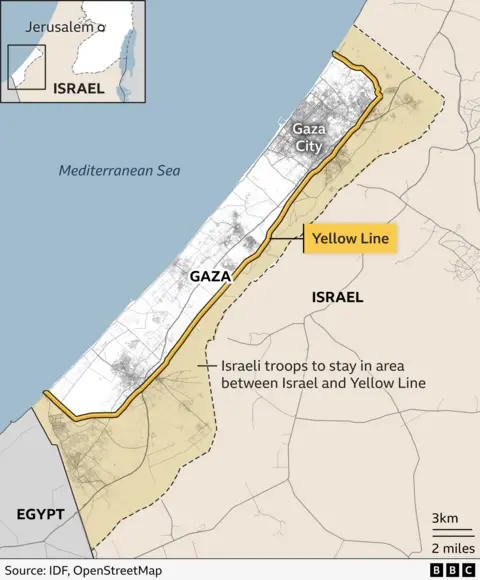Benedict Garman,Try the BBC and
Barbara Metzler,Try the BBC
 BBC
BBCIsrael has destroyed more than 1,500 buildings in areas of Gaza that remain under control from the cease-fire by Hamas as analyzed by the BBC show REAL.
New photos – the latest taken on 8 November – show that the entire neighborhood controlled by the Israel Defense Forces (IDF) was leveled in a month, without demolition.
The actual number of destroyed buildings could be much higher, with satellite imagery for some areas not available for analysis by BBC Verify.
Some experts argue that the demolitions could violate the terms of the cease-fire in the US, Egypt, Qatar and Turkey. But an IDF spokesman told the BBC it was acting “in accordance with the ceasefire”.
US President Donald Trump’s 20 Point Master Peace Plan for Gaza – The basis of the ceasefire – said that “Military Bombardment, including aerial bombardment and artillery, will be suspended”. He has always been said “war is too much”.
Visual Analysis by the BBC’s VISIFY on Satellite found that the destruction of buildings in Gaza by the Israeli military continues on a large scale. We use a modification of the algorithm to transform the radar images taken before and after the stoppage to highlight the changes, which can reveal the destruction, then repair the destruction of the buildings.
We look at the buildings behind the yellow line – a border that runs north, south east of Gaza. Under the October ceasefire agreement Israel agreed to withdraw its forces to that mark, marked by a yellow line on maps released by the IDF.
Houses, orchards and gardens renovated
Many of the damaged buildings were not seen damaged before being destroyed, for example, in eastern Khan ananis, around Abasan Al-Kabira.
It is difficult to be a conclusion from a satellite image taken from above, but these buildings did not find damage to their structure or tell the signs of the story like their outlines. There are houses with gardens, trees and some small orchards.
A comparison between satellite images of this area taken at the start of the war in October 2023 with images taken on the date of the cessation of renovation of many buildings.

Lana Khalil used to live in Abasan Al-Kabira before she moved to nearby al-Mawasi. He described his home as a “heaven” and full of “farms and vegetables”.
Today, like many other parts of Gaza, the area has been reduced to garbage.
“Israel did not leave us anything, they destroyed everything,” he said. Ms Khalil added that former residents could hear the demolition of the area “from our tents in al-Mawasi”.
“Our hearts are broken,” he said.
Elsewhere, near Al-Bayuk, east of the town of RAFAH, satellite imagery tells the same story. Many buildings that seem from above to not rot before the cease fire from not rotting. Aerial footage of a massive explosion published at the beginning of November showed dust rising from the ruins of the neighborhood.
Destruction also continues in Gaza City itself, in the eastern neighborhood of Shejaiya as well as near the Indonesia Hospital on the edge of the Jabalia camp.
Eitan Shamir, ex-shat of the National Security Docret Department of Securetic activities, that the actions of the IDF do not apply to areas outside the line of the yellow line.
Verified videos showing controlled demolitions and excavating floating buildings have been published on social media from stop-and-go areas behind the yellow line.

Demolition of a ‘ceasefire’
The IDF defended its actions and a spokesman said: “According to the agreement, all terrorism infrastructure, including tunnels throughout Gaza. Israel is acting in response to threats, violations, and terrorist infrastructure.”
On 18 October, Israel’s Defense Minister Katz wrote to X that “deminitarizing Gaza by destroying terrorist groups” is a “clear part of Israel’s policy.
Point 13 of Trump’s peace plan published by the White House – the closest thing released in terms of a ceasefire – including all “military facilities, and military diseases, and military facilities, and pursuit facilities, and shearing facilities, and terror, will be destroyed and not rebuilt”.
But it also said the demilitarization process in Gaza was “under the supervision of independent monitors”.
“This is definitely a violation of the ceasefire,” said Dr Ha Hellyer, a Rusi Associate Centre. “But [Washington] DC doesn’t want it to be known as such, insisting that the stoppage be stopped, even if it doesn’t really hold up. “
But Mr. Shamir denied the IDF broke the ceasefire. He told the BBC that according to his sources in the IDF there is a view that: “Hamas is allowed to do what it wants in the territory it controls.”
The IDF has concluded that it is highly unlikely that Hamas will abide by the second phase of the agreement, according to its source.
“Therefore, the space must be prepared for the continuation of the fight, so as not to leave [them] Any options to ambush our soldiers. “He also said that there are constant attempts by Hamas to float beyond the line and that there are still more sections of the tunnel to deal with.
Some analysts – such as Adil Haque, Professor of Law at Rutgers University – say that Israel may be violating the laws of war, which prohibit the destruction of civilian property by an occupying power.
He explained that exceptions to the rule can only arise “from military operations, that is, from fighting in combat,” that such destruction of civilian property is translated into full military operations “.
Hugh Lovatt, Senior Policy Advisor at the European Council on Foreign Relations, said in the end the demolitions would harm the peace plan.
“The problem of Israeli demolitions will grow the longer Israel remains in the zone behind the yellow line.
“In the long run, the feeling that Israel has stopped withdrawing and is seeking to create new permanent realities on the ground, as it has a greater threat to maintain the ceasefire.”
Additional Reporting by Alex Murray



